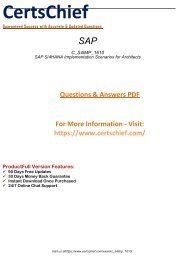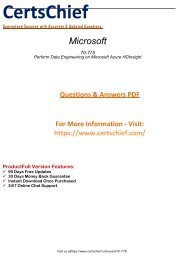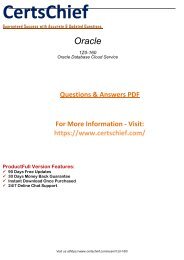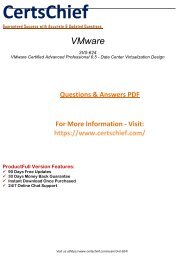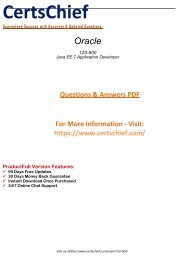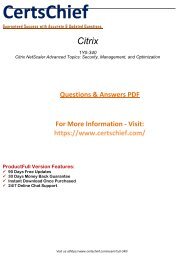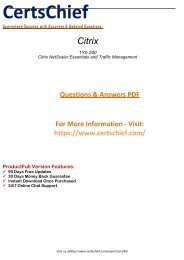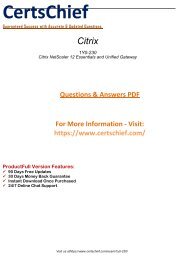210-260
Study units and arrangement materials gave by us to 210-260 Test are approved by the experts and industry specialists. You can without much of a stretch breeze through your accreditation test with our cerebrum dumps and PDF test questions. You can use discount coupon for 20% off 20off2018 .For more information please visit here: https://www.certschief.com/exam/210-260/
Study units and arrangement materials gave by us to 210-260 Test are approved by the experts and industry specialists. You can without much of a stretch breeze through your accreditation test with our cerebrum dumps and PDF test questions. You can use discount coupon for 20% off 20off2018 .For more information please visit here: https://www.certschief.com/exam/210-260/
You also want an ePaper? Increase the reach of your titles
YUMPU automatically turns print PDFs into web optimized ePapers that Google loves.
CertsChief<br />
Guaranteed Success with Accurate & Updated Questions.<br />
Cisco<br />
<strong>210</strong>-<strong>260</strong><br />
Implementing Cisco Network Security<br />
Questions & Answers PDF<br />
For More Information - Visit:<br />
https://www.certschief.com/<br />
ProductFull Version Features:<br />
90 Days Free Updates<br />
30 Days Money Back Guarantee<br />
Instant Download Once Purchased<br />
24/7 Online Chat Support<br />
Visit us athttps://www.certschief.com/exam/<strong>210</strong>-<strong>260</strong>/
Question: 1<br />
Which two services define cloud networks? (Choose two.)<br />
A. Infrastructure as a Service<br />
B. Platform as a Service<br />
C. Security as a Service<br />
D. Compute as a Service<br />
E. Tenancy as a Service<br />
Answer: A,B<br />
The NIST's definition of cloud computing defines the service models as follows:[2] + Software as a<br />
Service (SaaS). The capability provided to the consumer is to use the provider's applications running on a<br />
cloud infrastructure. The applications are accessible from various client devices through either a thin<br />
client interface, such as a web browser (e.g., web-based email), or a program interface. The consumer<br />
does not manage or control the underlying cloud infrastructure including network, servers, operating<br />
systems, storage, or even individual application capabilities, with the possible exception of limited userspecific<br />
application configuration settings.<br />
+ Platform as a Service (PaaS). The capability provided to the consumer is to deploy onto the cloud<br />
infrastructure consumer-created or acquired applications created using programming languages,<br />
libraries, services, and tools supported by the provider. The consumer does not manage or control the<br />
underlying cloud infrastructure including network, servers, operating systems, or storage, but has<br />
control over the deployed applications and possibly configuration settings for the application-hosting<br />
environment.<br />
+ Infrastructure as a Service (IaaS). The capability provided to the consumer is to provision processing,<br />
storage, networks, and other fundamental computing resources where the consumer is able to deploy<br />
and run arbitrary software, which can include operating systems and applications. The consumer does<br />
not manage or control the underlying cloud infrastructure but has control over operating systems,<br />
storage, and deployed applications; and possibly limited control of select networking components (e.g.,<br />
host firewalls).<br />
Source:<br />
https://en.wikipedia.org/wiki/Cloud_computing#Service_models<br />
Question: 2<br />
In which two situations should you use out-of-band management? (Choose two.)<br />
A. when a network device fails to forward packets<br />
B. when you require ROMMON access<br />
C. when management applications need concurrent access to the device<br />
D. when you require administrator access from multiple locations<br />
E. when the control plane fails to respond<br />
Visit us athttps://www.certschief.com/exam/<strong>210</strong>-<strong>260</strong>/
Answer: A,B<br />
OOB management is used for devices at the headquarters and is accomplished by connecting dedicated<br />
management ports or spare Ethernet ports on devices directly to the dedicated OOB management<br />
network hosting the management and monitoring applications and services. The OOB management<br />
network can be either implemented as a collection of dedicated hardware or based on VLAN isolation.<br />
Source:<br />
http://www.cisco.com/c/en/us/td/docs/solutions/Enterprise/Security/SAFE_RG/SAFE_rg/chap9.html<br />
Question: 3<br />
In which three ways does the TACACS protocol differ from RADIUS? (Choose three.)<br />
A. TACACS uses TCP to communicate with the NAS.<br />
B. TACACS can encrypt the entire packet that is sent to the NAS.<br />
C. TACACS supports per-command authorization.<br />
D. TACACS authenticates and authorizes simultaneously, causing fewer packets to be transmitted.<br />
E. TACACS uses UDP to communicate with the NAS.<br />
F. TACACS encrypts only the password field in an authentication packet.<br />
Question: 4<br />
Answer: A,B,C<br />
According to Cisco best practices, which three protocols should the default ACL allow on an access port<br />
to enable wired BYOD devices to supply valid credentials and connect to the network? (Choose three.)<br />
A. BOOTP<br />
B. TFTP<br />
C. DNS<br />
D. MAB<br />
E. HTTP<br />
F. 802.1x<br />
Answer: A,B,C<br />
ACLs are the primary method through which policy enforcement is done at access layer switches for<br />
wired devices within the campus.<br />
ACL-DEFAULT--This ACL is configured on the access layer switch and used as a default ACL on the port.<br />
Its purpose is to prevent un-authorized access.<br />
An example of a default ACL on a campus access layer switch is shown below:<br />
Extended IP access list ACL-DEFAULT<br />
Visit us athttps://www.certschief.com/exam/<strong>210</strong>-<strong>260</strong>/
10 permit udp any eq bootpc any eq bootps log (<strong>260</strong>4 matches) 20 permit udp any host 10.230.1.45 eq<br />
domain<br />
30 permit icmp any any<br />
40 permit udp any any eq tftp<br />
50 deny ip any any log (40 matches)<br />
As seen from the output above, ACL-DEFAULT allows DHCP, DNS, ICMP, and TFTP traffic and denies<br />
everything else.<br />
Source:<br />
http://www.cisco.com/c/en/us/td/docs/solutions/Enterprise/Borderless_Networks/Unified_Access/<br />
BYOD_Design_Guide/BYOD_Wired.html<br />
MAB is an access control technique that Cisco provides and it is called MAC Authentication Bypass.<br />
Question: 5<br />
Which two next-generation encryption algorithms does Cisco recommend? (Choose two.)<br />
A. AES<br />
B. 3DES<br />
C. DES<br />
D. MD5<br />
E. DH-1024<br />
F. SHA-384<br />
Answer: A,F<br />
The Suite B next-generation encryption (NGE) includes algorithms for authenticated encryption, digital<br />
signatures, key establishment, and cryptographic hashing, as listed here:<br />
+ Elliptic Curve Cryptography (ECC) replaces RSA signatures with the ECDSA algorithm + AES in the<br />
Galois/Counter Mode (GCM) of operation<br />
+ ECC Digital Signature Algorithm<br />
+ SHA-256, SHA-384, and SHA-512<br />
Source:<br />
Cisco Official Certification Guide, Next-Generation Encryption Protocols, p.97<br />
Question: 6<br />
Which three ESP fields can be encrypted during transmission? (Choose three.)<br />
A. Security Parameter Index<br />
B. Sequence Number<br />
C. MAC Address<br />
D. Padding<br />
E. Pad Length<br />
F. Next Header<br />
Visit us athttps://www.certschief.com/exam/<strong>210</strong>-<strong>260</strong>/
Answer: D,E,F<br />
The packet begins with two 4-byte fields (Security Parameters Index (SPI) and Sequence Number).<br />
Following these fields is the Payload Data, which has substructure that depends on the choice of<br />
encryption algorithm and mode, and on the use of TFC padding, which is examined in more detail later.<br />
Following the Payload Data are Padding and Pad Length fields, and the Next Header field. The optional<br />
Integrity Check Value (ICV) field completes the packet.<br />
Source:<br />
https://tools.ietf.org/html/rfc4303#page-14<br />
Question: 7<br />
What are two default Cisco IOS privilege levels? (Choose two.)<br />
A. 0<br />
B. 1<br />
C. 5<br />
D. 7<br />
E. 10<br />
F. 15<br />
Answer: B,F<br />
By default, the Cisco IOS software command-line interface (CLI) has two levels of access to commands:<br />
user EXEC mode (level 1) and privileged EXEC mode (level 15).<br />
Source:<br />
http://www.cisco.com/c/en/us/td/docs/ios/12_2/security/configuration/guide/fsecur_c/scfpass.html<br />
Question: 8<br />
Which two authentication types does OSPF support? (Choose two.)<br />
A. plaintext<br />
B. MD5<br />
C. HMAC<br />
D. AES 256<br />
E. SHA-1<br />
F. DES<br />
Answer: A,B<br />
Visit us athttps://www.certschief.com/exam/<strong>210</strong>-<strong>260</strong>/
These are the three different types of authentication supported by OSPF + Null Authentication--This is<br />
also called Type 0 and it means no authentication information is included in the packet header. It is the<br />
default.<br />
+ Plain Text Authentication--This is also called Type 1 and it uses simple clear-text passwords.<br />
+ MD5 Authentication--This is also called Type 2 and it uses MD5 cryptographic passwords.<br />
Source:<br />
http://www.cisco.com/c/en/us/support/docs/ip/open-shortest-path-first-ospf/13697-25.html<br />
Question: 9<br />
Which two features do CoPP and CPPr use to protect the control plane? (Choose two.)<br />
A. QoS<br />
B. traffic classification<br />
C. access lists<br />
D. policy maps<br />
E. class maps<br />
F. Cisco Express Forwarding<br />
Answer: A,B<br />
For example, you can specify that management traffic, such as SSH/HTTPS/SSL and so on, can be<br />
ratelimited (policed) down to a specific level or dropped completely.<br />
Another way to think of this is as applying quality of service (QoS) to the valid management traffic and<br />
policing to the bogus management traffic.<br />
Source:<br />
Cisco Official Certification Guide, Table 10-3 Three Ways to Secure the Control Plane, p.269<br />
Question: 10<br />
Which two statements about stateless firewalls are true? (Choose two.)<br />
A. They compare the 5-tuple of each incoming packet against configurable rules.<br />
B. They cannot track connections.<br />
C. They are designed to work most efficiently with stateless protocols such as HTTP or HTTPS.<br />
D. Cisco IOS cannot implement them because the platform is stateful by nature.<br />
E. The Cisco ASA is implicitly stateless because it blocks all traffic by default.<br />
Answer: A,B<br />
In stateless inspection, the firewall inspects a packet to determine the 5-tuple--source and destination IP<br />
addresses and ports, and protocol--information contained in the packet. This static information is then<br />
compared against configurable rules to determine whether to allow or drop the packet.<br />
Visit us athttps://www.certschief.com/exam/<strong>210</strong>-<strong>260</strong>/
In stateless inspection the firewall examines each packet individually, it is unaware of the packets that<br />
have passed through before it, and has no way of knowing if any given packet is part of an existing<br />
connection, is trying to establish a new connection, or is a rogue packet.<br />
Source:<br />
http://www.cisco.com/c/en/us/td/docs/wireless/asr_5000/19-0/XMART/PSF/19-PSF-Admin/19-PSF-<br />
Admin_chapter_01.html<br />
Question: 11<br />
Which three statements about host-based IPS are true? (Choose three.)<br />
A. It can view encrypted files.<br />
B. It can have more restrictive policies than network-based IPS.<br />
C. It can generate alerts based on behavior at the desktop level.<br />
D. It can be deployed at the perimeter.<br />
E. It uses signature-based policies.<br />
F. It works with deployed firewalls.<br />
Answer: A,B,C<br />
If the network traffic stream is encrypted, HIPS has access to the traffic in unencrypted form.<br />
HIPS can combine the best features of antivirus, behavioral analysis, signature filters, network firewalls,<br />
and application firewalls in one package.<br />
Host-based IPS operates by detecting attacks that occur on a host on which it is installed. HIPS works by<br />
intercepting operating system and application calls, securing the operating system and application<br />
configurations, validating incoming service requests, and analyzing local log files for after-the-fact<br />
suspicious activity.<br />
Source:<br />
http://www.ciscopress.com/articles/article.asp?p=1336425&seqNum=3<br />
Question: 12<br />
What three actions are limitations when running IPS in promiscuous mode? (Choose three.)<br />
A. deny attacker<br />
B. deny packet<br />
C. modify packet<br />
D. request block connection<br />
E. request block host<br />
F. reset TCP connection<br />
Answer: A,B,C<br />
Visit us athttps://www.certschief.com/exam/<strong>210</strong>-<strong>260</strong>/
In promiscuous mode, packets do not flow through the sensor. The disadvantage of operating in<br />
promiscuous mode, however, is the sensor cannot stop malicious traffic from reaching its intended<br />
target for certain types of attacks, such as atomic attacks (single-packet attacks). The response actions<br />
implemented by promiscuous sensor devices are post-event responses and often require assistance<br />
from other networking devices, for example, routers and firewalls, to respond to an attack.<br />
Source:<br />
http://www.cisco.com/c/en/us/td/docs/security/ips/7-0/configuration/guide/cli/cliguide7/<br />
cli_interfaces.html<br />
Question: 13<br />
When an IPS detects an attack, which action can the IPS take to prevent the attack from spreading?<br />
A. Deny the connection inline.<br />
B. Perform a Layer 6 reset.<br />
C. Deploy an antimalware system.<br />
D. Enable bypass mode.<br />
Answer: A<br />
Deny connection inline: This action terminates the packet that triggered the action and future packets<br />
that are part of the same TCP connection. The attacker could open up a new TCP session (using different<br />
port numbers), which could still be permitted through the inline IPS.<br />
Available only if the sensor is configured as an IPS.<br />
Source:<br />
Cisco Official Certification Guide, Table 17-4 Possible Sensor Responses to Detected Attacks, p.465<br />
Question: 14<br />
What is an advantage of implementing a Trusted Platform Module for disk encryption?<br />
A. It provides hardware authentication.<br />
B. It allows the hard disk to be transferred to another device without requiring re-encryption.dis<br />
C. It supports a more complex encryption algorithm than other disk-encryption technologies.<br />
D. It can protect against single points of failure.<br />
Answer: A<br />
Trusted Platform Module (TPM) is an international standard for a secure cryptoprocessor, which is a<br />
dedicated microcontroller designed to secure hardware by integrating cryptographic keys into devices.<br />
Software can use a Trusted Platform Module to authenticate hardware devices. Since each TPM chip has<br />
a unique and secret RSA key burned in as it is produced, it is capable of performing platform<br />
authentication.<br />
Source:<br />
Visit us athttps://www.certschief.com/exam/<strong>210</strong>-<strong>260</strong>/
https://en.wikipedia.org/wiki/Trusted_Platform_Module#Disk_encryption<br />
Question: 15<br />
What is the purpose of the Integrity component of the CIA triad?<br />
A. to ensure that only authorized parties can modify data<br />
B. to determine whether data is relevant<br />
C. to create a process for accessing data<br />
D. to ensure that only authorized parties can view data<br />
Answer: A<br />
Integrity for data means that changes made to data are done only by authorized individuals/systems.<br />
Corruption of data is a failure to maintain data integrity.<br />
Source:<br />
Cisco Official Certification Guide, Confidentiality, Integrity, and Availability, p.6<br />
Question: 16<br />
In a security context, which action can you take to address compliance?<br />
A. Implement rules to prevent a vulnerability.<br />
B. Correct or counteract a vulnerability.<br />
C. Reduce the severity of a vulnerability.<br />
D. Follow directions from the security appliance manufacturer to remediate a vulnerability.<br />
Answer: A<br />
In general, compliance means conforming to a rule, such as a specification, policy, standard or law.<br />
Source:<br />
https://en.wikipedia.org/wiki/Regulatory_compliance<br />
Question: 17<br />
Which type of secure connectivity does an extranet provide?<br />
A. other company networks to your company network<br />
B. remote branch offices to your company network<br />
C. your company network to the Internet<br />
D. new networks to your company network<br />
Visit us athttps://www.certschief.com/exam/<strong>210</strong>-<strong>260</strong>/
Answer: A<br />
What is an Extranet? In the simplest terms possible, an extranet is a type of network that crosses<br />
organizational boundaries, giving outsiders access to information and resources stored inside the<br />
organization's internal network (Loshin, p. 14).<br />
Source:<br />
https://www.sans.org/reading-room/whitepapers/firewalls/securing-extranet-connections-816<br />
Question: 18<br />
Which tool can an attacker use to attempt a DDoS attack?<br />
A. botnet<br />
B. Trojan horse<br />
C. virus<br />
D. adware<br />
Answer: A<br />
Denial-of-service (DoS) attack and distributed denial-of-service (DDoS) attack. An example is using a<br />
botnet to attack a target system.<br />
Source:<br />
Cisco Official Certification Guide, Table 1-6 Additional Attack Methods, p.16<br />
Question: 19<br />
What type of security support is provided by the Open Web Application Security Project?<br />
A. Education about common Web site vulnerabilities.<br />
B. A Web site security framework.<br />
C. A security discussion forum for Web site developers.<br />
D. Scoring of common vulnerabilities and exposures.<br />
Answer: A<br />
The Open Web Application Security Project (OWASP) is a worldwide not-for-profit charitable<br />
organization focused on improving the security of software. Our mission is to make software security<br />
visible, so that individuals and organizations are able to make informed decisions . OWASP is in a unique<br />
position to provide impartial, practical information about AppSec to individuals, corporations,<br />
universities, government agencies and other organizations worldwide.<br />
Source:<br />
https://www.owasp.org/index.php/Main_Page<br />
Visit us athttps://www.certschief.com/exam/<strong>210</strong>-<strong>260</strong>/
Question: 20<br />
What type of attack was the Stuxnet virus?<br />
A. cyber warfare<br />
B. hacktivism<br />
C. botnet<br />
D. social engineering<br />
Answer: A<br />
Stuxnet is a computer worm that targets industrial control systems that are used to monitor and control<br />
large scale industrial facilities like power plants, dams, waste processing systems and similar operations.<br />
It allows the attackers to take control of these systems without the operators knowing. This is the first<br />
attack we've seen that allows hackers to manipulate real-world equipment, which makes it very<br />
dangerous.<br />
Source:<br />
https://us.norton.com/stuxnet<br />
Question: 21<br />
What type of algorithm uses the same key to encrypt and decrypt data?<br />
A. a symmetric algorithm<br />
B. an asymmetric algorithm<br />
C. a Public Key Infrastructure algorithm<br />
D. an IP security algorithm<br />
Answer: A<br />
A symmetric encryption algorithm, also known as a symmetrical cipher, uses the same key to encrypt<br />
the data and decrypt the data.<br />
Source:<br />
Cisco Official Certification Guide, p.93<br />
Question: 22<br />
Refer to the exhibit.<br />
Visit us athttps://www.certschief.com/exam/<strong>210</strong>-<strong>260</strong>/
How many times was a read-only string used to attempt a write operation?<br />
A. 9<br />
B. 6<br />
C. 4<br />
D. 3<br />
E. 2<br />
Answer: A<br />
To check the status of Simple Network Management Protocol (SNMP) communications, use the show<br />
snmp command in user EXEC or privileged EXEC mode.<br />
Illegal operation for community name supplied: Number of packets requesting an operation not allowed<br />
for that community<br />
Source:<br />
http://www.cisco.com/c/en/us/td/docs/ios/netmgmt/command<br />
Question: 23<br />
Refer to the exhibit.<br />
Visit us athttps://www.certschief.com/exam/<strong>210</strong>-<strong>260</strong>/
Which statement about the device time is true?<br />
A. The time is authoritative, but the NTP process has lost contact with its servers.<br />
B. The time is authoritative because the clock is in sync.<br />
C. The clock is out of sync.<br />
D. NTP is configured incorrectly.<br />
E. The time is not authoritative.<br />
Answer: A<br />
Remember: The [.] at the beginning of the time tells us the NTP process has last contact with its servers.<br />
We know the time is authoritative because there would be a [*] at the beginning if not.<br />
Question: 24<br />
How does the Cisco ASA use Active Directory to authorize VPN users?<br />
A. It queries the Active Directory server for a specific attribute for the specified user.<br />
B. It sends the username and password to retrieve an ACCEPT or REJECT message from the Active<br />
Directory server.<br />
C. It downloads and stores the Active Directory database to query for future authorization requests.<br />
D. It redirects requests to the Active Directory server defined for the VPN group.<br />
Answer: A<br />
When ASA needs to authenticate a user to the configured LDAP server, it first tries to login using the<br />
login DN provided. After successful login to the LDAP server, ASA sends a search query for the username<br />
provided by the VPN user. This search query is created based on the naming attribute provided in the<br />
configuration. LDAP replies to the query with the complete DN of the user. At this stage ASA sends a<br />
second login attempt to the LDAP server. In this attempt, ASA tries to login to the LDAP server using the<br />
VPN user's full DN and password provided by the user. A successful login to the LDAP server will indicate<br />
that the credentials provided by the VPN user are correct and the tunnel negotiation will move to the<br />
Phase 2.<br />
Source:<br />
http://www.networkworld.com/article/2228531/cisco-subnet/using-your-active-directory-for-vpnauthentication-on-asa.html<br />
Question: 25<br />
Visit us athttps://www.certschief.com/exam/<strong>210</strong>-<strong>260</strong>/
Which statement about Cisco ACS authentication and authorization is true?<br />
A. ACS servers can be clustered to provide scalability.<br />
B. ACS can query multiple Active Directory domains.<br />
C. ACS uses TACACS to proxy other authentication servers.<br />
D. ACS can use only one authorization profile to allow or deny requests.<br />
Answer: A<br />
ACS can join one AD domain. If your Active Directory structure has multi-domain forest or is divided into<br />
multiple forests, ensure that trust relationships exist between the domain to which ACS is connected<br />
and the other domains that have user and machine information to which you need access. So B is not<br />
correct.<br />
Source:<br />
http://www.cisco.com/c/en/us/td/docs/net_mgmt/cisco_secure_access_control_system/5-8/ACS-<br />
ADIntegration/guide/Active_Directory_Integration_in_ACS_5-8.pdf + You can define multiple<br />
authorization profiles as a network access policy result. In this way, you maintain a smaller number of<br />
authorization profiles, because you can use the authorization profiles in combination as rule results,<br />
rather than maintaining all the combinations themselves in individual profiles. So D. is not correct + ACS<br />
5.1 can function both as a RADIUS and RADIUS proxy server. When it acts as a proxy server, ACS receives<br />
authentication and accounting requests from the NAS and forwards the requests to the external RADIUS<br />
server. So C. is nor correct.<br />
Source:<br />
http://www.cisco.com/c/en/us/td/docs/net_mgmt/cisco_secure_access_control_system/5-<br />
1/user/guide/ acsuserguide/policy_mod.html<br />
Question: 26<br />
Refer to the exhibit.<br />
If a supplicant supplies incorrect credentials for all authentication methods configured on the switch,<br />
how will the switch respond?<br />
A. The supplicant will fail to advance beyond the webauth method.<br />
B. The switch will cycle through the configured authentication methods indefinitely.<br />
Visit us athttps://www.certschief.com/exam/<strong>210</strong>-<strong>260</strong>/
C. The authentication attempt will time out and the switch will place the port into the unauthorized<br />
state.<br />
D. The authentication attempt will time out and the switch will place the port into VLAN 101.<br />
Answer: A<br />
Flexible authentication (FlexAuth) is a set of features that allows IT administrators to configure the<br />
sequence and priority of IEEE 802.1X, MAC authentication bypass (MAB), and switch-based web<br />
authentication (local WebAuth).<br />
Case 2: Order MAB Dot1x and Priority Dot1x MAB<br />
If you change the order so that MAB comes before IEEE 802.1X authentication and change the default<br />
priority so that IEEE 802.1X authentication precedes MAB, then every device in the network will still be<br />
subject to MAB, but devices that pass MAB can subsequently go through IEEE 802.1X authentication.<br />
Special consideration must be paid to what happens if a device fails IEEE 802.1X authentication after<br />
successful MAB. First, the device will have temporary network access between the time MAB succeeds<br />
and IEEE 802.1X authentication fails. What happens next depends on the configured event-fail behavior.<br />
If next-method is configured and a third authentication method (such as WebAuth) is not enabled, then<br />
the switch will return to the first method (MAB) after the held period. MAB will succeed, and the device<br />
will again have temporary access until and unless the supplicant tries to authenticate again.<br />
If next-method failure handling and local WebAuth are both configured after IEEE 802.1X authentication<br />
fails, local WebAuth ignores EAPoL-Start commands from the supplicant.<br />
MAB -->MAB Pass--> Port Authorized by MAB --> EAPoL-Start Received --> IEEE 802.1x<br />
MAB -->MAB Fail--> IEEE 802.1x<br />
(config-if)#authentication order mab dot1x<br />
(config-if)#authentication priority dot1x mab<br />
Source:<br />
http://www.cisco.com/c/en/us/products/collateral/ios-nx-os-software/identity-based-networkingservice/<br />
application_note_c27-573287.html<br />
Question: 27<br />
Which command do you enter to configure your firewall to conceal internal addresses?<br />
A. no ip inspect audit-trail<br />
B. ni ip inspect<br />
C. no ip directed-broadcast<br />
D. no ip source-route<br />
E. no proxy-arp<br />
F. no ip logging facility<br />
Question: 28<br />
Answer: E<br />
Visit us athttps://www.certschief.com/exam/<strong>210</strong>-<strong>260</strong>/
You are configuring a NAT rule on a Cisco ASA. Which description of a mapped interface is true?<br />
A. It is mandatory for all fire wall modes.<br />
B. It is mandatory for identity NAT only.<br />
C. It is optional in transparent mode.<br />
D. It is optional in routed mode.<br />
Answer: D<br />
Visit us athttps://www.certschief.com/exam/<strong>210</strong>-<strong>260</strong>/
Powered by TCPDF (www.tcpdf.org)<br />
For More Information - Visit:<br />
https://www.certschief.com/<br />
20% Discount Coupon Code:<br />
20off2018<br />
Visit us athttps://www.certschief.com/exam/<strong>210</strong>-<strong>260</strong>/<br />
http://www.certschief.com/exam/0B0-104/<br />
Page | 1





